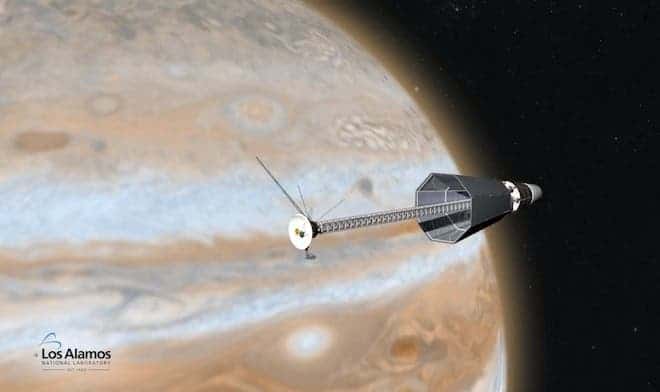
Scientists at the Los Alamos National Laboratory have successfully tested out the prototype for a nuclear-reactor engine, meant to serve in the future as an “a simple, reliable space power system.” Although the experiment, dubbed Demonstration Using Flattop Fissions (DUFF), rendered only 24 watts of power, barely enough to power a common household light bulb, the system can obviously be scaled and provide basic footing for future space exploration probes or even spacecraft design for deep space.
To me at least, it’s rather curious how simple the system is. The small nuclear reactor is powered by uranium and acts a Stirling engine, which most of you motor-heads out there are more than familiarized with. Invented in 19th century, the Stirling engine provides mechanical energy which can then be converted in electricity, for instance, from a simple to-and-fro movement of a pressurized piston. Cooling is ensured by a, yet again, simple heat pipe, which is also used extensively in electronics cooling. That’s no warp-drive, folks.
The researchers claim a 50-pound hunk of enriched uranium that sits inside a 12-inch reactor core could power eight Stirling engines to produces as much as 500 watts of power. This is the first space-orientated nuclear reactor experiment since 1965. Around that time NASA launched the nuclear powered Voyager-1 and Voyager-2, and to this day they remain operational. In fact, Voyager-1 is on the brink of reaching interstellar space, which would officially make it the first man-made object to leave our solar system.
“The heat pipe and Stirling engine used in this test are meant to represent one module that could be used in a space system,” Marc Gibson of NASA Glenn Research Center said a Los Alamos statement. “A flight system might use several modules to produce approximately one kilowatt of electricity.”
The Voyager probes however run on plutonium-238, and since 1992 the US has currently no means of producing plutonium-238 anymore. Uranium on the other hand is fairly abundant.
Applications for the nuclear-engine would be numerous, from reliable space probes that can go on for decades or more sophisticated deep space satellites that can afford the energy cost of sophisticated instruments. It’s rather peculiar that both the DOE and NASA have invested so little in space applications powered by nuclear energy. The video below illustrates the Los Alamos scientists’ small nuclear reactor capabilities.
via Wired


